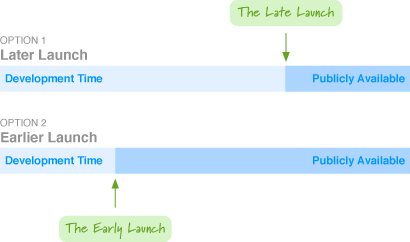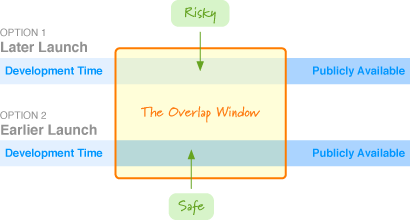You really have two options. Launch earlier or launch later. That part is fairly straightforward. The hard part is figuring out where those points are on your development timeline.

That’s simple enough, but, if we think about it, the time to implement a certain set of features is going to be the same regardless of when we launch. “Feature X” is going to take two weeks to build whether we launch today or launch after it’s implemented.
However, if we launch today, we’ll be providing a working product a month earlier for everyone who doesn’t need “Feature X”. We may even discover that nobody wants “Feature X” and that we should instead be focusing on “Feature Y”. Or maybe they just want “Feature Y” first. Either way, the earlier launch is exposing you to real ideas from real customers, and that can only help.

Even if you launch without some features, they aren’t going anywhere. You can launch now without the features and add them in a month, or you can launch in a month with the features. Either way, a month from now, you’ll be in about the same place.
So what’s the real dilemma? I can’t quite put my finger on it, but sometimes it’s hard to cut back on an original vision. Other times, I suppose it’s a matter of feeling like we have to have all of the features that the competitors have. Either way, it’s too easy to become fixated on the vision in our head. There’s inherently more risk in delaying the launch than there is in coming up short on features.

If you launch earlier, there’s a chance you may learn that you prioritized the new features incorrectly. As an added bonus, an earlier launch means revenue will be coming the door sooner as well. Alternatively, if you delay the launch and work on the wrong features, you’ve just misused the most valuable asset you have. Time. That’s a hell of a lot worse than putting out a product that’s too simple.
The only real risk is that people could be underwhelmed with the initial release, and the launch could be anti-climactic. However, that’s really not a bad thing. It just means we have more time to listen to people and give them what they really want in the next release. That doesn’t seem like such a bad option to me.